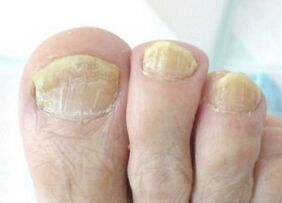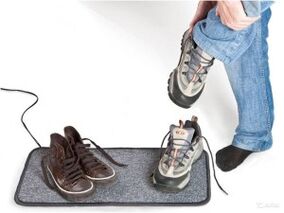Not everyone knows what toenail fungus looks like.In this sense, not all patients know when to go to the doctor.If you notice signs of nail fungus, you should also determine what stage the disease is in, and then immediately contact a specialist.
Symptoms of the disease
The first symptoms of foot or hand fungus are usually not so noticeable.In most cases it is a small injury to the nail.The side edges of the plate, as well as the free edge, begin to acquire a yellowish color.The presence of the disease can also be recognized by the lack of transparency of the nail at the base.
Sometimes you can see a space between the disc and the bed itself.The reasons for its formation are the accumulation of fungal pathogens, as well as other microbes.These types of lesions are called distal-lateral fungal form.

In addition, fungus on the hands or feet is complemented by hyperkeratosis located under the nails.This name implies the phenomenon when the nail begins to react to the presence of a fungus by keratinizing the bed itself.The deeper the fungus penetrates into the plaque, the thicker the fingernails or toenails become.
The final stage of this form is the destruction of the entire nail.Also, the matrix begins to participate in the process - this is the place where the nail begins to grow.Lamellar dystrophy occurs.
Additionally, the symptoms of the fungus intensify.Damage to the nail begins with small white spots.Over time, the types of these places become more diverse and extensive.Additionally, these symptoms can be recognized due to the loose and rough nail plate.It is easily exposed when scraped.However, this shape is not found in the hands.It is relevant for the first finger.
The symptoms of the next form of infection, proximal subungual, are lesions of the pad, which become red.After this, the tissues around the fingernails and toenails begin to swell and shine, after which the shape changes.The result will be the separation of the cuticle from the plate.
Any person is afraid to discover a fungus on himself, because it is dangerous, because the next stage is degenerative changes in the nail plate.The first symptoms of this form are unevenness.They are easy to recognize;They look like uneven grooves throughout the nail.If the disease is completely neglected, it is possible to completely lose a fingernail or toenail.
The most dangerous fungus is found in the complete dystrophic form.This is the most advanced disease.The nail (if preserved) appears gray and thickens.The main symptom is the total or partial destruction of the plaque.
We are fighting the scourge

Before starting to treat fungus on hands and feet, it is necessary to minimize the negative influence from the outside.It is advisable to find the reasons why fungus appeared on hands or feet and eliminate them.Most often there are four reasons:
- Frequent exposure to hot and humid environments.The thing is that it is necessary to dry your shoes, especially during halftime, when they are constantly wet.Tights and socks should be chosen only from natural materials that do not create problems with heat and air exchange.
- Often the causes of hand and foot fungus lie in poor immunity.It is enough to walk barefoot on the ground for the infection to spread.
- Frequent nail extensions are also among the most common causes of onychomycosis.It is advisable not to repeat the procedure more than once every six months.
- Any analysis will show that the most contagious fungus is the active spores.They can penetrate the gaps between the fingers and toes, remain dormant, and then begin to grow sharply.This type of fungus is found in public places.
Even if you notice the first symptoms of fungus, which are described above, you should not start self-medication.It is necessary to go to a specialist who will do an analysis.In most cases, a scrape test is performed to check for fingernail and toenail fungus.This analysis is carried out in an alkaline environment, where the presence of mycelium is checked under a microscope.
Only after the test shows a positive result can treatment begin.The fact is that the first signs of hand and foot fungus may not be fungus at all and may have completely different causes.For example, problems with internal organs are also negatively reflected on the nail plates.Then a more complete analysis will be necessary, which in most cases includes a biochemical blood test.

To determine the causes of the fungus, doctors recommend analyzing the etiology of the microorganism.This analysis is carried out within three weeks, during which the corresponding culture is grown.Although there are currently modern techniques that allow the DNA of the fungus to be analyzed to determine the cause of its formation.
Common species
Among all hand and foot fungus, there are three most popular types.The first of them is epidermophytosis.We are talking about a fungal disease that affects not only the fingernails and toenails, but also the skin that surrounds them.Most often you can find this type of fungus in a bathhouse or gym.
How is nail fungus transmitted?It's all quite prosaic.These are general hygiene products, bedding, oilcloths, mats and other sports equipment and even thermometers.Most often, this type of fungus appears on the legs of men.It appears less frequently on the hands due to the lack of excessive sweating.
Trichophytosis of the feet is also very common.This is due to the fact that the disease has a high level of contagiousness.It is also transmitted through objects used by a sick person, including sports equipment.It is extremely rare for children to be affected by this type of fungus.
Most often, young men are at risk, but the percentage is even higher among the adult population.Often this disease can be found in miners or workers in hot-type workshops.In Europe, this disease is often given the “title” of “athlete's foot.”This type of fungus does not occur on the hands.
The third most common variant is candidiasis.It is also found in the feet;It usually does not reach the hands.Most of these types of fungi are conditionally pathogenic, so they are present in all people without causing disease.However, with reduced immunity, its pathogenicity can be observed.Additionally, they can enter the body through dirty hands, after sharing objects, as well as through fermented dairy products.
In general, these are the main types of fungi you should be careful with in public places.In most cases, protecting yourself from the disease is quite simple.Use only your personal items.Remember to wear slippers in the shower or pool, and always visit a specialist if you suspect a fungus.Do not try to self-medicate or self-diagnose.Even an experienced doctor needs a laboratory test to be completely sure.


















